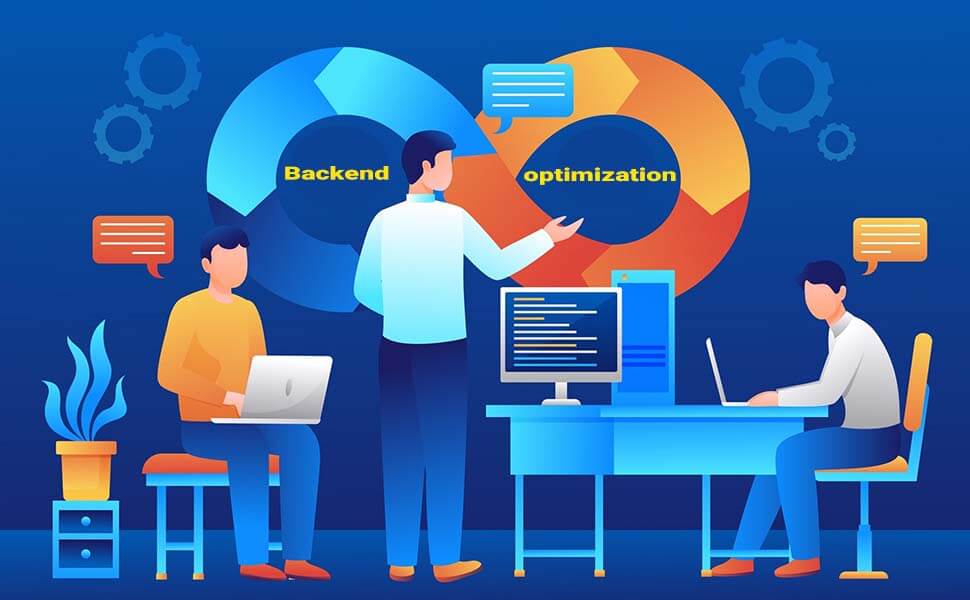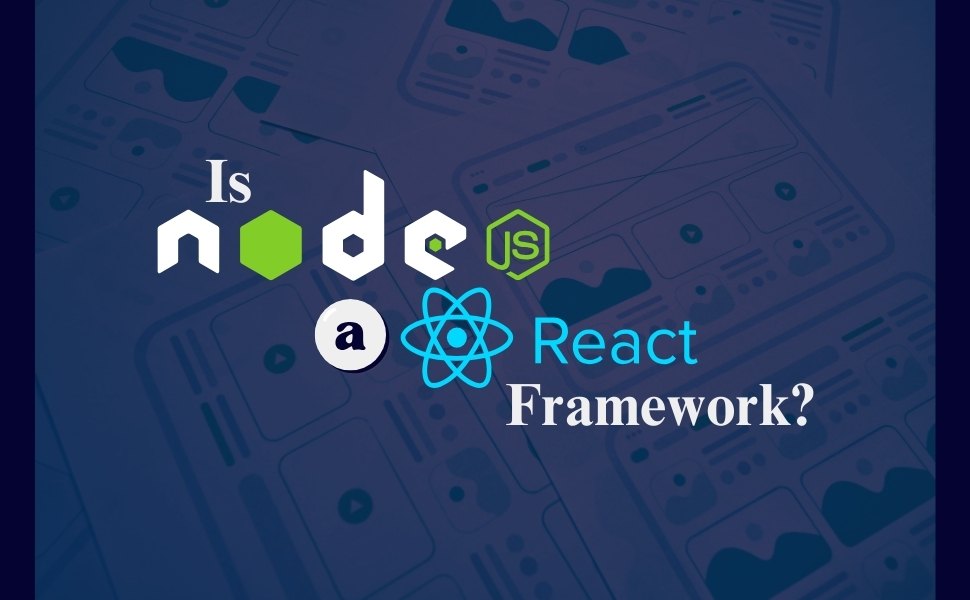A well-optimized backend is the backbone of any high-performing application. It ensures smooth operations, faster processing, and seamless user experiences. Backend optimization strategies focus on improving server efficiency, database management, and code performance. By addressing bottlenecks, it helps handle increased traffic and boosts overall reliability.
In the following sections, we will explore what backend optimization is and its role in enhancing application performance. We’ll also dive into the key aspects of backend optimization and discuss practical strategies for optimizing backend performance. Finally, we’ll share valuable tips for optimizing backend performance for long-term success.
Learn about the frontend frameworks as well.
What is Backend Optimization?
Backend optimization, also known as backend performance optimization, is the process of improving the efficiency of the server-side components of an application. It involves optimizing servers, databases, and application logic to ensure faster response times and smooth operations. The goal is to reduce bottlenecks, handle higher traffic loads, and deliver a seamless experience to users.
By focusing on areas like code efficiency, server configurations, and database management, backend optimization ensures applications perform well under pressure. It helps to optimize performance, making systems more reliable, scalable, and responsive. This is essential for businesses looking to provide uninterrupted services to their users.
Related: Top 10 Mobile App Development Frameworks
Strategies to Optimize Backend Performance
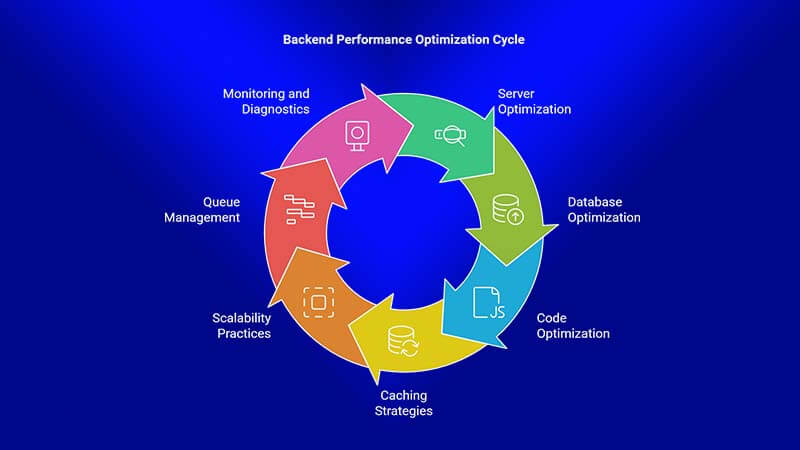
Optimizing backend performance is essential for delivering fast, reliable, and scalable applications. By using proven techniques and advanced tools, businesses can enhance efficiency and handle growing demands with ease. In this section, we’ll explore practical strategies to ensure your backend performs at its best, even under high traffic. So, let’s now learn how to optimize backend performance for high-traffic applications.
Server Optimization
Server optimization is critical in managing backend performance. With the right server configurations, you can efficiently handle traffic surges and ensure your system remains responsive.
- Choose the Right Server: Whether it’s a dedicated server, a cloud-based solution, or a hybrid approach, pick the infrastructure that best matches your application’s needs. Cloud platforms like AWS or Google Cloud offer flexibility and scalability.
- Load Balancing: Distribute incoming traffic across multiple servers. Load balancing prevents overloading any single server, improving the system’s responsiveness.
- Optimizing Server Software: Software like Nginx and Apache are designed to handle high volumes of traffic. Tuning these servers can drastically improve performance and reduce response times.
- Enhance Redundancy: Implement server clustering or failover mechanisms to ensure high availability. This way, your system remains operational even if one server faces issues.
Database Optimization
Optimizing your database is essential to handling large amounts of data and ensuring quick retrieval, especially during high-traffic periods.
- Index Frequently Queried Data: Properly indexing your data tables can dramatically improve query speed and reduce database load.
- Cache Repeated Queries: Cache frequently accessed data to minimize repeated database calls, reducing server load and enhancing performance.
- Partition Large Tables: Splitting large tables into smaller partitions can optimize data retrieval and improve performance under heavy traffic.
- Simplify Complex Queries: Streamline queries to avoid inefficient operations like unnecessary joins. This speeds up data retrieval and improves response time.
Code Optimization
Efficient backend code improves speed, reduces resource consumption, and enhances the overall user experience. Well-written code can make all the difference, especially for high-traffic apps.
- Refactor Inefficient Code: Remove redundant or unnecessary code. Simplified code executes faster and requires fewer resources.
- Optimize Algorithms: Review your algorithms to ensure they are optimal. Inefficient algorithms can slow down the system, especially under heavy loads.
- Avoid Blocking Calls: Use asynchronous operations whenever possible. This allows your system to handle multiple tasks simultaneously without blocking important processes.
Caching Strategies
Caching is an effective way to store and retrieve frequently used data without hitting the database, boosting backend performance.
- Implement In-Memory Caching: Use tools like Redis or Memcached to store frequently requested data in memory, reducing the time it takes to retrieve it.
- Leverage CDNs: Use Content Delivery Networks (CDNs) to cache static resources like images, CSS files, and JavaScript. This reduces load times by serving them from edge locations closer to the user.
- Database Query Caching: Cache the results of frequent database queries. This reduces the load on your database and speeds up data access times.
- HTTP Caching: Use HTTP caching to store and serve content directly from the client’s browser, minimizing the need to fetch data from the server repeatedly.
Scalability Practices
For a backend to scale efficiently, it must be designed to handle growth in both data and traffic. Scalability ensures your application can handle increasing demand without slowing down.
- Horizontal Scaling: Adding more servers to distribute the load helps ensure your application can handle increased traffic. This is often a more effective approach than upgrading hardware on a single server.
- Vertical Scaling: If your system requires more power, upgrade your existing server by increasing CPU, RAM, or storage. While this improves performance, it has limits compared to horizontal scaling.
- Auto-Scaling: Set up automatic scaling, especially in cloud environments, so the system can scale up or down based on traffic needs in real time.
- Microservices Architecture: Break down monolithic applications into smaller services that can scale independently. This approach ensures better resource utilization and performance under heavy load.
Queue Management
Efficient queue management helps prevent backend overload by organizing tasks and controlling the flow of data.
- Use Background Task Queues: Offload long-running tasks to background queues so that your system can focus on handling immediate requests.
- Prioritize Tasks: Assign priority levels to different tasks, ensuring that critical processes are completed first, reducing delays.
- Throttling and Rate Limiting: Prevent server overload by limiting the number of requests a user can make within a specified time. This improves server stability and fairness.
Monitoring and Diagnostics
Proactively monitoring your backend’s performance ensures that issues are identified early before they impact users.
- Real-Time Monitoring: Tools like Prometheus or Datadog provide real-time insights into system performance, allowing you to track important metrics like response times and server load.
- Error Tracking: Tools such as Sentry capture errors as they occur. This helps developers quickly identify and resolve issues.
- Load Testing: Run load tests to simulate high-traffic situations and identify performance bottlenecks before they affect real users.
- Health Checks: Implement periodic health checks to ensure your system is running smoothly and proactively detect any potential issues.
By applying a mix of these techniques, you can significantly improve your backend’s efficiency, enabling it to handle higher loads and provide a seamless experience to users.
Advanced Techniques for High-Traffic Backend Optimization
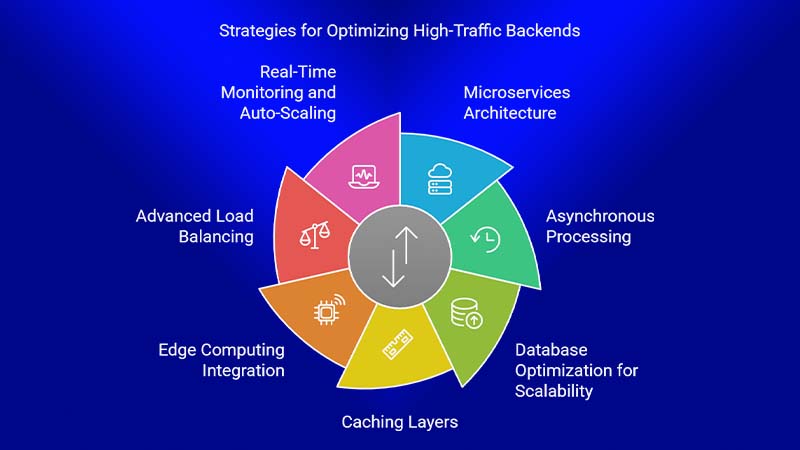
Optimizing backend performance for high-traffic applications requires more advanced strategies. These methods ensure scalability, reliability, and efficiency, even under heavy loads. Let’s explore some cutting-edge practices to master backend performance.
Microservices Architecture
Microservices divide an application into smaller, independent services that can be scaled and optimized individually. This modular approach improves resilience and performance in high-traffic systems.
- Service Isolation: Each service operates independently, minimizing the risk of system-wide failures. If one microservice experiences high load, others remain unaffected.
- Independent Scaling: Scale individual services based on demand. For example, scale the authentication service during a login surge without overloading other parts of the system.
- Polyglot Persistence: Use the best database for each microservice’s specific needs, such as NoSQL for dynamic content and relational databases for structured data.
Asynchronous Processing
Asynchronous techniques handle tasks in the background, reducing the load on the main application. This improves response times and overall efficiency.
- Queue Management: Use message queues like RabbitMQ or Kafka to process heavy tasks asynchronously, such as image processing or email notifications.
- Event-Driven Architecture: Trigger tasks based on events, ensuring only necessary actions are performed, reducing unnecessary backend strain.
- Background Jobs: Schedule non-critical operations, like data syncing or report generation, during off-peak hours.
Database Optimization for Scalability
High-traffic applications often face database bottlenecks. Optimizing databases ensures quick data retrieval and efficient handling of large volumes of requests.
- Sharding: Split databases into smaller, manageable pieces, distributing them across multiple servers to handle more traffic efficiently.
- Connection Pooling: Use pooled connections to manage database access, reducing latency and increasing performance during peak loads.
- Index Optimization: Ensure proper indexing to speed up query execution and minimize search times.
Caching Layers
Caching significantly reduces backend load by storing frequently accessed data for quick retrieval. This ensures faster response times and reduces server requests.
- Distributed Caching: Use distributed systems like Redis or Memcached for scalable and efficient caching solutions across multiple servers.
- API Caching: Cache API responses to prevent repetitive processing of identical requests.
- Content Delivery Caching: Pair caching with CDNs to store static and dynamic content closer to users.
Edge Computing Integration
Edge computing processes data closer to the user’s location rather than relying entirely on a central server. This reduces latency and enhances the performance of high-traffic applications.
- Localized Processing: Handle computational tasks at edge nodes, reducing the load on the central backend.
- IoT and Real-Time Data: Optimize real-time applications like IoT systems by processing data at the edge, ensuring quick responses.
- Reduced Bandwidth Usage: Minimize data sent to the central server, saving bandwidth and lowering costs.
Advanced Load Balancing
Sophisticated load-balancing techniques ensure even distribution of traffic, improving the reliability and responsiveness of backend systems.
- Geographic Load Balancing: Direct traffic to servers based on the user’s location, improving speed and reducing latency.
- Application-Aware Load Balancers: Use intelligent load balancers that understand application logic, ensuring optimal resource allocation.
- Dynamic Traffic Shaping: Adjust traffic distribution based on server performance and user demand in real-time.
Real-Time Monitoring and Auto-Scaling
Continuous monitoring and automated scaling enable systems to adapt dynamically to changing traffic patterns, maintaining optimal performance.
- Performance Dashboards: Use tools like Grafana or Datadog to monitor backend performance metrics, such as server load and response times.
- Auto-Scaling Mechanisms: Automatically scale resources up or down based on traffic spikes or dips, using services like AWS Auto Scaling or Kubernetes.
- Predictive Analytics: Leverage machine learning to predict traffic trends and prepare the backend for future demands.
These strategies provide a robust foundation for scalability, reliability, and efficiency, even under the most demanding conditions.
Languages You Can Use to Backend Optimization
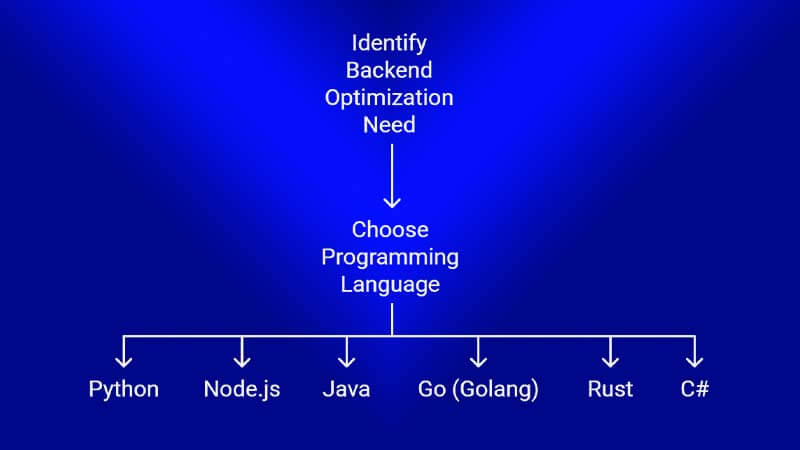
You can use some highly efficient languages to optimize the performance of backend applications. These languages are specifically designed to handle complex processes and ensure smooth functionality. We’ll now learn about the standout features that make them ideal for backend optimization. Efficient Backend, Superior Performance.
- Python
- Node.js
- Java
- Go (Golang)
- Rust
- C#
Let’s now learn the features of these languages. You know these best web development backend languages are great for performance optimization in Backend Development.
Features of Highly Effective Backend Optimization Languages
1. Python
➟ Known for its simplicity and versatility.
➟ Frameworks like Django and Flask provide tools for quick development and optimization.
➟ Ideal for handling complex computations and integrating caching mechanisms.
2. Node.js
➟ Built for asynchronous programming language, making it highly scalable.
➟ Efficient for handling concurrent requests in real-time applications.
➟ Great for lightweight backend services and microservices.
3. Java
➟ Offers strong performance and scalability.
➟ Widely used in enterprise-grade applications with frameworks like Spring Boot.
➟ Excellent for optimizing multi-threaded backend systems.
4. Go (Golang)
➟ Designed for high performance and simplicity.
➟ Handles concurrent operations efficiently, making it suitable for high-traffic applications.
➟ Compiles to machine code for faster execution.
5. Rust
➟ Focuses on performance and memory safety.
➟ Ideal for resource-intensive tasks and real-time applications.
➟ Guarantees optimized concurrency handling and low-level control.
6. C#
➟ Great for building scalable and secure backend systems with .NET Core.
➟ Provides robust features for managing data, APIs, and caching.
➟ Well-suited for enterprise applications.
These languages stand out for their ability to handle backend processes efficiently, ensuring reliability, scalability, and optimized performance in high-traffic environments.
Tips to Optimize Backend Performance
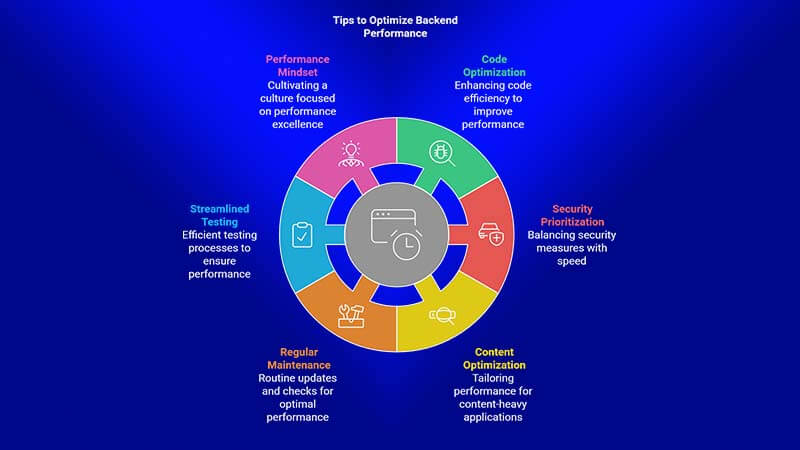
Fine-tuning backend performance involves adopting best practices and proactive measures. These tips to optimize backend performance help address inefficiencies and improve overall system responsiveness.
Code Optimization
Writing efficient and clean code plays a vital role in backend performance optimization. Poorly written code can slow down even the most powerful servers.
- Minimize Redundant Code: Avoid duplicate logic and unnecessary complexity to reduce execution time.
- Efficient Algorithms: Use algorithms that offer the best trade-off between speed and memory usage for specific operations.
- Regular Refactoring: Continuously update and refine code to improve clarity and efficiency.
Prioritize Security Without Sacrificing Speed
Security measures are essential, but they should not compromise performance. A balanced approach is crucial.
- Token-Based Authentication: Use lightweight authentication methods like JWTs to minimize server strain.
- Efficient Data Encryption: Opt for encryption techniques that ensure security without slowing down requests.
- Monitor Vulnerabilities: Regularly update libraries and frameworks to fix potential security issues before they affect performance.
Optimize for Content-Driven Applications
For content-driven web apps, backend performance optimization ensures quick delivery of dynamic and static content.
- Content Caching: Store frequently accessed pages and media files in a cache to reduce database queries.
- CDN Integration: Use a content delivery network to offload traffic and improve content delivery speed.
- API Optimization: Ensure APIs return only necessary data to minimize processing time and bandwidth usage.
Regular Maintenance and Updates
Consistent monitoring and updating of backend systems help prevent performance degradation.
- System Updates: Keep backend frameworks, libraries, and servers updated to leverage the latest features and security patches.
- Log Management: Use tools like ELK Stack to organize and analyze server logs, identifying potential issues early.
- Database Cleanup: Remove unused or outdated data to enhance query speed and reduce storage costs.
Streamline Backend Testing
Testing ensures that your backend operates smoothly and efficiently under different conditions.
- Load Testing: Simulate high traffic to evaluate how the backend handles stress.
- Unit Testing: Test individual components to ensure they work correctly and efficiently.
- Continuous Integration: Automate testing during development to catch and fix performance issues early.
Adopt a Performance-First Mindset
Performance optimization in backend development requires a proactive approach and long-term commitment.
- Proactive Monitoring: Use real-time dashboards to identify bottlenecks and resolve them before they escalate.
- Scalability Planning: Design the backend with scalability in mind, ensuring it can grow with application needs.
- Skill Development: Continuously learn and adapt new techniques to improve backend skills and stay updated with trends.
If you apply these backend optimization strategies, you create a system that is robust and capable of handling growing traffic and user demands. Whether you’re working on high-traffic applications or content-driven web apps, a well-optimized backend framework ensures a seamless experience for users. Keep refining your approach to achieve an efficient backend, superior performance for your application.
Common Challenges and How to Overcome Them
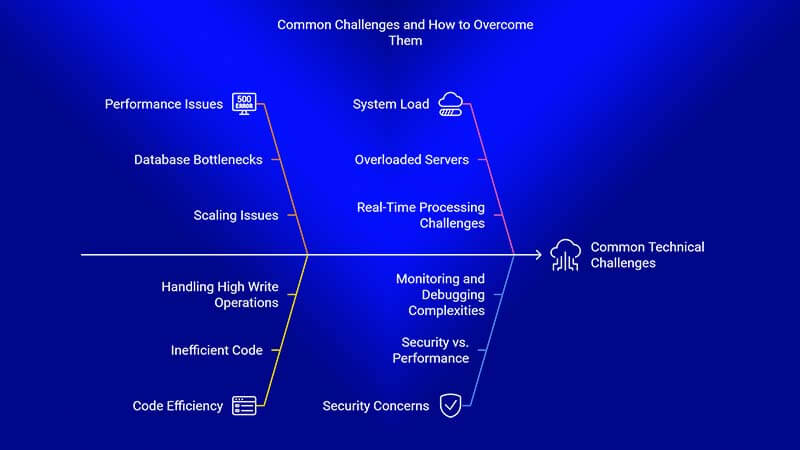
Backend optimization often comes with its own set of challenges, especially when dealing with high-traffic applications. Identifying these hurdles and addressing them effectively ensures a smoother and more efficient system. Below are some common challenges and practical solutions.
Database Bottlenecks
Handling large volumes of data and complex queries can slow down backend performance. This challenge becomes more prominent as traffic scales.
- Solution: Use indexing to speed up query processing. Implement database sharding to distribute data across multiple servers, and consider caching frequently accessed data to reduce the load on the database.
Scaling Issues
Applications often struggle to handle sudden spikes in traffic, leading to slow response times or server crashes.
- Solution: Leverage cloud-based solutions that allow auto-scaling of resources based on demand. Horizontal scaling (adding more servers) and vertical scaling (upgrading hardware) can also help address scalability challenges effectively.
Inefficient Code
Poorly optimized code can lead to slow application response times and increased server load.
- Solution: Regularly review and refactor code to eliminate inefficiencies. Optimize algorithms for faster execution and use tools like profilers to identify performance bottlenecks in the codebase.
Overloaded Servers
Servers may get overwhelmed when handling simultaneous requests from high-traffic applications, resulting in latency issues.
- Solution: Use load balancing to distribute requests evenly across multiple servers. Implement asynchronous processing for resource-intensive tasks and offload static content delivery to CDNs.
Security vs. Performance
Striking the right balance between robust security measures and optimal performance can be tricky.
- Solution: Use lightweight security solutions like token-based authentication, for example- fintech security app solution. Ensure efficient encryption techniques are in place and regularly update software to address vulnerabilities without compromising speed.
Real-Time Processing Challenges
Applications requiring real-time updates, such as chat systems or stock market platforms, can struggle to maintain low latency.
- Solution: Employ WebSockets for persistent connections and real-time communication. Utilize edge computing to process data closer to the user and reduce latency.
Monitoring and Debugging Complexities
Identifying and fixing performance issues in large, distributed systems can be challenging.
- Solution: Implement comprehensive monitoring tools like Datadog or Grafana to track metrics and logs. Use distributed tracing to pinpoint issues across multiple services quickly.
Handling High Write Operations
Applications with frequent data writes, such as e-commerce platforms, may experience slow performance due to database contention.
- Solution: Use write-optimized databases like DynamoDB or implement batching to group multiple write operations into a single transaction.
By recognizing these common challenges and addressing them proactively, you can ensure consistent and reliable backend performance. Overcoming these obstacles is crucial for building scalable and high-performing systems that meet user demands effortlessly.
Are you facing any of the issues that we discussed here?
Are you encountering any of the challenges we’ve outlined here? Whether it’s database bottlenecks, scaling issues, or optimizing for high-traffic applications, these problems can hinder your system’s performance. By addressing these challenges with the right strategies and tools, you can ensure your backend operates at its best. If you’re ready to overcome these obstacles and need expert assistance, let’s discuss how we can help!
Read more: Web Application Development Services of Boomdevs
Transform Your Business with BoomDevs
At BoomDevs, we specialize in creating robust, high-performing backend systems tailored to your business needs. Whether you’re dealing with high-traffic applications, content-driven platforms, or scaling challenges, our experts are here to help.
✅ Custom Solutions: Designed to meet your specific requirements.
✅ Optimized Performance: Maximize speed and efficiency with proven strategies.
✅ Expert Support: Dedicated professionals committed to your success.
Take the first step toward superior performance today!
🌐 Visit BoomDevs.com or 📞 Contact us now to discuss your project. Let’s turn your vision into reality!
Contact Us Today!
Get the best consultation.
Frequently Asked Questions:
Q1: What are the signs that my backend needs optimization?
A1: Several signs indicate your backend might need optimization, such as slow response times, frequent server crashes, high CPU or memory usage, delayed database queries, and an inability to handle increased traffic. These issues often point to inefficiencies in code, server configuration, or database management.
Q2: How does caching improve backend performance?
A2: Caching stores frequently accessed data in memory, reducing the need for repetitive database queries or processing. This results in faster data retrieval and minimizes the load on servers, enhancing overall performance. Tools like Redis or Memcached are commonly used for effective caching. Read more to know more.
Q3: What role does API optimization play in backend performance?
A3: Optimizing APIs ensures they process and deliver data quickly and efficiently. Techniques include reducing payload size, avoiding over-fetching or under-fetching data, and implementing rate limiting to prevent server overload. Well-optimized APIs enhance the user experience and backend scalability.
Q4: How can I monitor backend performance in real time?
A4: Real-time backend performance monitoring involves using tools like Grafana, Datadog, or New Relic. These tools track metrics such as response times, error rates, and server resource usage, helping you identify and resolve performance issues proactively.
Q5: What is the importance of asynchronous processing in backend optimization?
A5:Asynchronous processing allows tasks to run in the background without blocking the main application workflow. This is crucial for handling time-consuming operations like file uploads or database writes, ensuring the application remains responsive for users.
Q6: How can load balancing benefit my backend infrastructure?
A6: Load balancing distributes incoming traffic evenly across multiple servers, preventing any single server from becoming overwhelmed. This improves application availability, ensures faster response times, and reduces the risk of downtime, especially during traffic spikes. Learn more.
Q7: What are some common backend frameworks for performance optimization?
A7: Popular backend frameworks for optimizing performance include Node.js, Django, and Spring Boot. These frameworks offer built-in tools and libraries for handling high traffic, optimizing database queries, and managing resources effectively, making them ideal for modern web applications.
Wrapping Up:
Backend Optimization is essential for ensuring smooth, reliable, and scalable application performance. By addressing bottlenecks, optimizing server configurations, and implementing advanced techniques, you can create a system that handles high traffic effortlessly. These strategies not only improve user satisfaction but also position your business for long-term success. Start optimizing your backend today to unlock its full potential!



